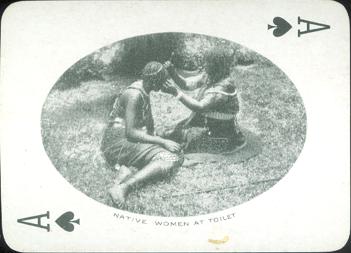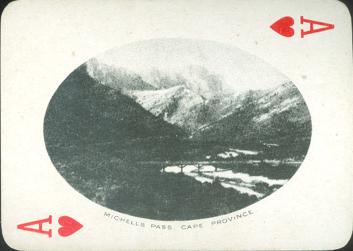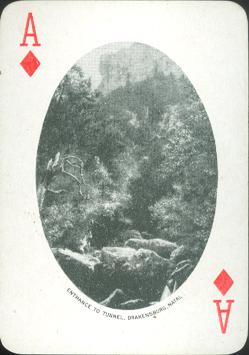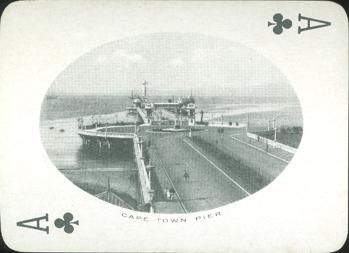July 2013
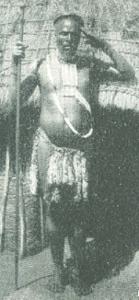 |
It was a
very pleasant month here, with lots of dry, sunny and warm days. We even
had a short heat wave. So not a month to spend at the pc, but rather one
to spend in the garden or..... at outside markets. We did quite a few,
but they brought us more joy than decks. For the slightly cooler
evenings our agenda was reasonably filled with social engagements, but
we managed to follow the offer on the usual auction sites. |
|
The Dutch
one was completely uninteresting and on Ebay we didn't win many of the
bookmarked decks. We wouldn't call our bids stingy, but at the important
auctions we were outbid every time. So at the end of the month there
wasn't a very interesting short list and a choice was easily made. We
didn't choose the nice Cider deck, made for the French market by Carta
Mundi, nor the Curator deck by artist Emmanuel JosÚ, who uses a very
interesting technique, cutting, for his designs. Instead we chose this
souvenir deck. It came in a partial box, which didn't have the most
important part, the top lid with possibly some information. |
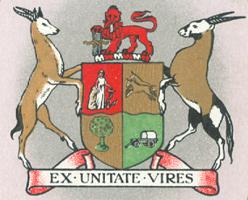 |
There was no extra card either to provide us with any further
information , so we had to search for that elsewhere. Of course we first
went through our modest library, but neither Gary, nor the Dawson's
Encyclopedia, nor the Fournier catalogue brought any answers. We went through
John Berry's Waddington books, even though we thought that the deck would
be older than 1922. Of course we used the internet too, but the WWPCM didn't
show this deck and the search engine didn't bring any sites that showed this
deck either.
We often found
references to another South African souvenir deck, by the USPCC from around 1910
(Dawson Encyclopedia). But that deck has a different back design, with the
statue of Jan van Riebeek. The shown oval b/w pictures are different and
they have a greenish or brownish colour. The joker shows the Kimberly rough
diamonds, which same picture can be found in this deck on the 8 of Hearts.
Another South African souvenir deck was made by the Darter Brothers & Co
from Cape Town, but that uses both square and oval pictures and has a different
joker and back design.
So for us this is still a mystery deck and if there's
anyone out there with more information, please step forward.
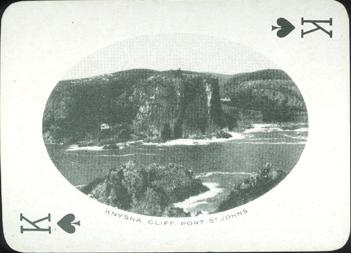
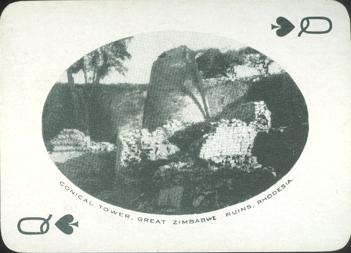
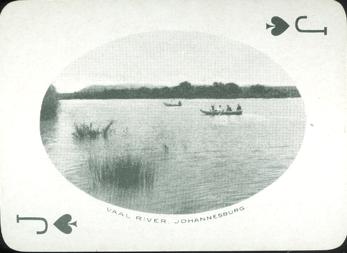
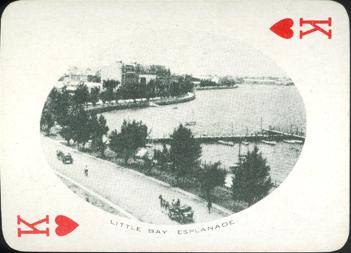
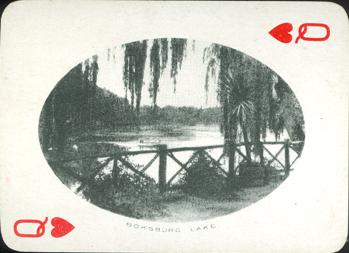
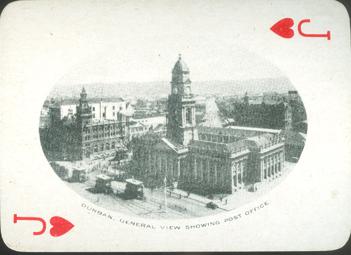
Dating a deck by
the used pictures is always a bit hazardous. The pictures can be years older
than the deck. South Africa has a beautiful nature, but pictures of a waterfall
or scenery are almost timeless. There are a few pictures that show human
inventions, like automobiles or trams. The horse-carriages (KH) were still in
use next to automobiles, even the mail was delivered by them (4H). The Durban
double deck tramway had stopped using horses since the electrification in 1902
and on the JH there are no horses pulling the tram and the poles for the
electrical wires are visible. We're not connoisseurs of antique cars, but the
ladies bathing suits on the 7D and 8C still have that Victorian look. But the
deck was obviously published after the unification of South Africa in 1910.
Although many
"Afrikaner" (descendants of Dutch settlers) still see the 17th century
Jan van Riebeek as a founding father, his image is not used on any card in this
deck. Instead there are three cards with a reference to Cecil Rhodes. His statue
is on the 5C, his memorial monument (erected in 1912) is on the 3D and his grave
(1902) on the 5D. Of course the role of this English businessman in the
establishment of the Union of South Africa was a much more direct one than that of Jan
van Riebeek, but the absence Van Riebeek and obvious presence of Rhodes make us
suspect that this deck has an Anglo-Saxon background. And the date? Based on the
above we would say 1915 - 1920.
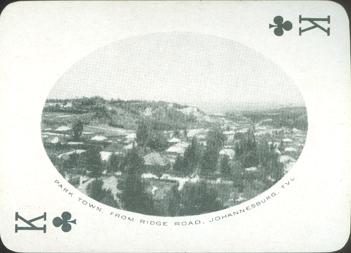
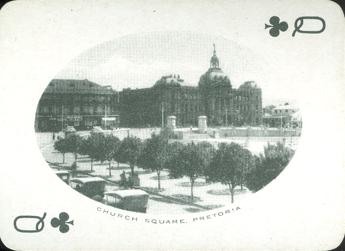
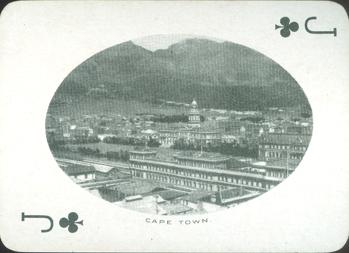
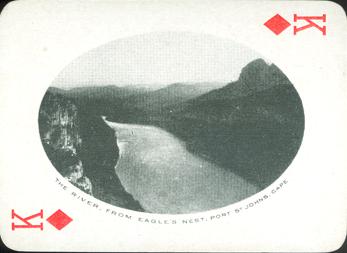
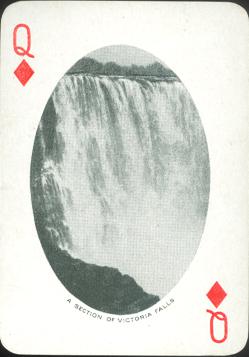
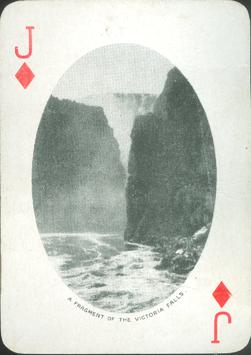
The Union of South
Africa was established on May 31, 1910. It was created by the unification of 4
former English colonies: Transvaal, the Orange Free State Republic, the Colony
of Natal and the Cape Colony. The back design shows the initial coat of arms of
the new state. It was in use from the 17th September 1910, when it was granted
by King George V, until it was slightly revised in 1930.
The 4 former colonies are represented in the 4 quarters of the shield. The
figure of Hope in the first quarter represent the Cape Colony (of good Hope).
The two "wildebeests" in the second quarter represent the Colony of
Natal. The orange tree in the third quarter is a symbol for the Orange Free
State and the wagon in the fourth quarter stands for Transvaal. The shield is
supported by a springbok (left), taken from the Orange River Colony's coat of
arms, and the oryx (gemsbok), taken from the Cape Colony's coat of arms. On top
is the lion on top holds four rods, bound together, symbolizing the unification
of the four former colonies. The lion itself may be a reference to both England
and the Netherlands, which countries both have lions in their coats of arms.
The official South African translation of the Latin "ex unitate vires"
was "Union is Strength" until 1961, thereafter it became the more
accurate "Unity is Strength".
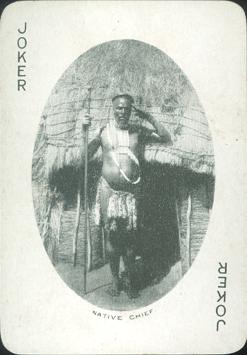
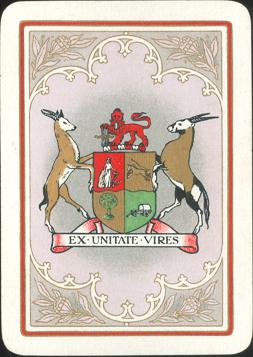
The deck consists
of 52 cards and one joker.
Lots of information, but still the most important is
missing here. So should anyone have information about date, maker or publisher,
we'll welcome that here.
AND WE GOT A RESPONS!
 |
In
2018 I joined several groups about playing cards and now (03-2024) in
the Pre-1950 group my American friend and fellow-collector Matt
Schacht wanted to show this deck, but had seen this page and my quest
for information. So more than 10 years after I asked about this
information, he provided pics of the extra card which came with his deck
and wasn't in ours. It describes all the scenes in the deck. Although it
doesn't give a date, it does provide the name of the printer/publisher.
Alas he did not have the original box either. |
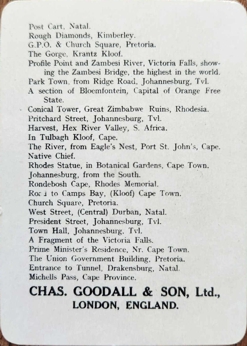 |
But..... a big THANKS, Matt!
BACK TO PRESENT MONTH








